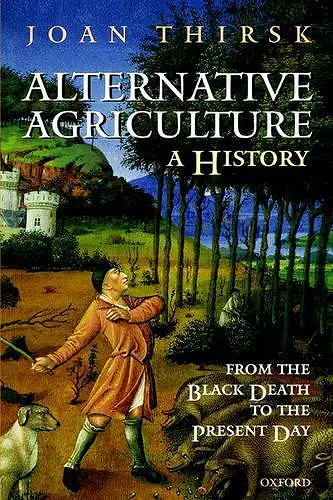Alternative Agriculture: A History
From the Black Death to the Present Day
Format:Paperback
Publisher:Oxford University Press
Currently unavailable, and unfortunately no date known when it will be back
This paperback is available in another edition too:
- Hardback£120.00(9780198206620)

People like to believe in a past golden age of traditional English countryside, before large farms, machinery, and the destruction of hedgerows changed the landscape forever. However, that countryside may have looked both more and less familiar than we imagine. Take todays startling yellow fields of rapeseed, seemingly more suited to the landscape of Van Gogh than Constable. They were, in fact, thoroughly familiar to fieldworkers in seventeenth-century England. At the same time, some features that would have gone unremarked in the past now seem like oddities. In the fifteenth century, rabbit warrens were specially guarded to rear rabbits as a luxury food for rich mens tables; whilst houses had moats not only to defend them but to provide a source of fresh fish. In the 1500s we find Catherine of Aragon introducing the concept of a fresh salad to the court of Henry VIII; and in the 1600s, artichoke gardens became a fashion of the gentry in their hope of producing more male heirs. The common tomato, suspected of being poisonous in 1837, was transformed into a household vegetable by the end of the nineteenth century, thanks to cheaper glass-making methods and the resulting increase in glasshouses. In addition to these images of past lives, Joan Thirsk reveals how the forces which drive our current interest in alternative forms of agriculture a glut of meat and cereal crops, changing dietary habits, the needs of medicine have striking parallels with earlier periods in our history. She warns us that todays decisions should not be made in a historical vacuum: we can find solutions to our current problems in the experience of people in the past.
This study is rigorously researched, wide-ranging and largely aimed at the reader who is already pretty well versed in agricultural history. It is fluidly written in a style which is both congenial and lucid. * Karen Sayer, Southern History, Vol 19/20 1999. *
there is a sense of fidelity which protects her work against the vagaries of academic fashion. Nowhere are these qualities clearer than in Alternative Agriculture. Firstly, there is the sheer scale and learning of the book ... it moves easily and with elegance from an England traumatized by the Black Death to an England learning to live with BSE ... this is not only a broad-sweep history but also a complex and minute examination of the processes of agricultural change ... Alternative Agriculture is a marvellous justification of the historian's craft - a book which is both a careful and engrossing account of our past and a text which speaks into current debates and arguments. I wish I had written it. * Alun Howkins, History Workshop Journal, vol 47, 1999 *
bristles with such fascinating details which challenge notions about what is traditional and what is innovative in English agriculture ... Thirsk's stimulating and often entertaining account is partly a work of history and partly a manifesto on the future of agriculture. * Clare Griffiths, Wadham College, Oxford, EHR June 1999 *
ISBN: 9780198208136
Dimensions: 234mm x 155mm x 21mm
Weight: 575g
384 pages